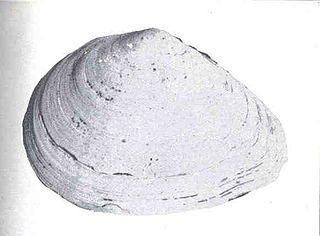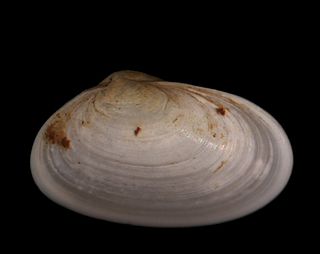
Bivalvia, in previous centuries referred to as the Lamellibranchiata and Pelecypoda, is a class of marine and freshwater molluscs that have laterally compressed bodies enclosed by a shell consisting of two hinged parts. As a group, bivalves have no head and they lack some usual molluscan organs, like the radula and the odontophore. They include the clams, oysters, cockles, mussels, scallops, and numerous other families that live in saltwater, as well as a number of families that live in freshwater. The majority are filter feeders. The gills have evolved into ctenidia, specialised organs for feeding and breathing. Most bivalves bury themselves in sediment, where they are relatively safe from predation. Others lie on the sea floor or attach themselves to rocks or other hard surfaces. Some bivalves, such as the scallops and file shells, can swim. The shipworms bore into wood, clay, or stone and live inside these substances.

A siphon is an anatomical structure which is part of the body of aquatic molluscs in three classes: Gastropoda, Bivalvia and Cephalopoda.

Donax is a genus of small, edible saltwater clams, marine bivalve molluscs. The genus is sometimes known as bean clams or wedge shells; however, Donax species have numerous different common names in different parts of the world. In the southeastern U.S. they are known as "coquina", a word that is also used for the hard limestone concretions of their shells and those of other marine organisms.

Mactridae, common name the trough shells or duck clams, is a family of saltwater clams, marine bivalve mollusks in the order Venerida.

A bivalve shell is part of the body, the exoskeleton or shell, of a bivalve mollusk. In life, the shell of this class of mollusks is composed of two hinged parts or valves. Bivalves are very common in essentially all aquatic locales, including saltwater, brackish water, and freshwater. The shells of bivalves commonly wash up on beaches and along the edges of lakes, rivers, and streams. Bivalves by definition possess two shells or valves, a "right valve" and a "left valve", that are joined by a ligament. The two valves usually articulate with one another using structures known as "teeth" which are situated along the hinge line. In many bivalve shells, the two valves are symmetrical along the hinge line—when truly symmetrical, such an animal is said to be equivalved; if the valves vary from each other in size or shape, inequivalved. If symmetrical front-to-back, the valves are said to be equilateral, and are otherwise considered inequilateral.

Macoma nasuta, commonly known as the bent-nosed clam, is a species of bivalve found along the Pacific Ocean coast of North America. It is about 6 cm (2.4 in) long. It is often found buried in sands of 10–20 cm (3.9–7.9 in) in depth. This rounded clam has no radial ribs. Archaeological data supports the use of this species by Native Americans such as the Chumash peoples of central California.

Mya truncata, common name the blunt gaper or truncate softshell, is a species of edible saltwater clam, a marine bivalve mollusk in the family Myidae.

Donax gouldii, common name the bean clam, is a species of small saltwater clam, a marine bivalve mollusk in the family Donacidae.

Ensis ensis, or the sword razor, is a razor clam, a marine bivalve mollusc in the family Pharidae. It lives buried in the sand and is found off the coasts of northwest Europe.

Fabulina fabula, the bean-like tellin, is a species of marine bivalve mollusc in the family Tellinidae. It is found off the coasts of northwest Europe, where it lives buried in sandy sediments.

Tellina tenuis, the thin tellin, is a species of marine bivalve mollusc in the family Tellinidae. It is found off the coasts of northwest Europe and in the Mediterranean Sea, where it lives buried in sandy sediments.

Tellimya ferruginosa is a species of small marine bivalve mollusc in the family Lasaeidae. It is found on the eastern side of the Atlantic Ocean.
Phaxas pellucidus, the transparent razor shell, is a species of marine bivalve mollusc in the family Pharidae. It is found buried in the seabed in coastal waters of northwest Europe, often in great numbers.

Lutraria is a genus of medium-sized marine bivalve mollusks or clams, commonly known as otter shells.

Corculum cardissa, the heart cockle, is a species of marine bivalve mollusc in the family Cardiidae. It is found in the Indo-Pacific region. It has a symbiotic relationship with dinoflagellates (zooxanthellae), which live within its tissues.

Cyrtopleura costata, or the angel wing clam, is a bivalve mollusc in the family Pholadidae. It is found in shallow parts of the northwest Atlantic and also in the North Sea of Scotland coastline and west coast of the Adriatic Sea by a remote area in the Marche region in central Italy, living in the seabed, where it digs its burrows on a very slow revolving movement for years through soft sand and mud always to a max depth of 8ft but always below 3 feet (0.91 m) at the lowest tide.
Laternula elliptica is a species of saltwater clam, a marine bivalve mollusc in the family Laternulidae, the lantern shells. It is the largest bivalve found under the surface of the seabed in the Southern Ocean.

Macoma tenta, the narrowed macoma clam or elongate macoma is a species of clam, a marine bivalve mollusk (bivalvia) in the family Tellinidae and genus Macoma. Macoma tenta are one of two species of macoma clams that can be found in the Chesapeake Bay on the eastern shore of the United States in Maryland and Virginia. The macoma tenta like their cousin in the Chesapeake, the Macoma balthica or Baltic macoma clam, are small marine bivalves with thin, chalky white shells. They tend to live buried in the sandy or muddy areas of shallow water in the middle and lower Chesapeake Bay. Macoma clams are among the most abundant clams in the Chesapeake Bay. Macomas first appeared about 750,000 years ago.

Solecurtus strigilatus, also known as the rosy razor clam, is a species of saltwater clam, a marine bivalve mollusc in the family Solecurtidae. This mollusc is a suspension feeder and can burrow with great rapidity to escape predators. It is an unusual bivalve in that its shell valves are too small to contain all the soft tissue, and the animal is unable to retreat into its shell.

Pharus legumen, is a species of bivalve mollusc commonly found burrowed in the sand on lower shores and in the shallow sublittoral.


















